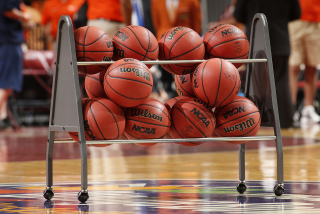Young Inventors Prove That the Future Is Wow
- Share via
IRVINE — Standing in front of brief poster-board explanations of his work, the young inventor proudly showed off his new product--a necklace-like device called “Elliot’s edible shirtsaver.”
Using Lifesavers, popcorn, rice cookies and string, kindergarten student Elliot Conn of Laguna Beach had designed the “shirtsaver” “to prevent me from chewing on my collar,” he explained. “Instead of eating my shirt,” Elliot said happily, “I eat my necklace.”
Elliot was one of 260 children from Tustin, Laguna Beach and Irvine who competed Saturday in an unusual “invention fair” for kindergarten through eighth-graders called “Astounding Inventions of the Future.”
Held for the fifth year by Irvine Valley College, the event was true to its name. Its youthful participants showed off creations that could be variously described as visionary, fanciful, down-to-earth-practical--or in some cases just plain “earthy.”
Among the prototypes on display--some of which actually appeared to work--were “a car that runs on air,” a dog collar that lights up at night, a “book alarm” designed to wake a parent who nods off while reading to his child, and a “see-through diaper” so parents can tell instantly when the baby is wet. There was also an assortment of pooper scoopers, including one by Michael Smith, 7, of Irvine, with a trowel attached to a sneaker so its wearer does not have to bend over to retrieve the offending mess.
This unusual science fair is part of a national “Invent America” competition, designed to spur interest in science, math, written expression, and most of all, creativity, said Dorothy Terman, science and math coordinator for the Irvine Unified School District, who helped start the Irvine version.
“Over 50% of U.S. patents went to foreigners this year. We’re very interested in rekindling some of that activity” in a new generation of American children, she said.
The United States Patent Model Foundation, a private educational foundation based in Washington, sponsored the competition. Contributors donated $3,000 in savings bonds to first- through third-place winners.
Although it’s too early to tell if the children who participate will pursue science in college or careers, they clearly love the opportunity to invent things, Terman said.
“We have the kids excited,” so excited that when they finish this year’s project “they are already thinking of the next project,” she said. And “sometimes the kids who aren’t the most academic” are among the most ardent inventors.
Saturday’s participants and their fascinated parents said they were delighted to be there.
Laguna Beach kindergarten student Joshua Bloch won honorable mention among kindergarten through second-graders for designing “stick on sunshades,” a visor-like device that sticks directly onto the face and requires no earpiece.
But two hours before Joshua knew that he had a good chance to win, the boy said he was enjoying everything about the fair. And yes, he told a questioner, he wanted to be a scientist when he grows up because “this is fun.”
Added his father, attorney Jerry Bloch: “This is exciting. It gives them something to work on that doesn’t restrict them the way school can.” Joshua not only thought up the idea of the unusual sunglasses, Bloch said, but also “he got to work on the computer” to illustrate his project, generating pretty much by himself an effective computer graphic of the glasses to go with the fair’s required “Inventor’s Log.”
Even children who did not expect to win said they were having fun.
“I don’t think I came close. I’ve seen some really good ones (projects),” said Brandi Pate, 11, a sixth-grader from Irvine. In addition, the judges’ questions about her project were “really hard,” she and several friends said, and she hadn’t known how to answer everything.
Still, that was OK, Brandi said, because “well, I just really liked creating this.” Her invention? A prototype for a robot called “‘Mrs. Plutra, the Bedroom Cleaner.”
With a boxy figure, sugar-cube eyes, Styrofoam cup legs, a line of coins to depict her switches plus a nearby canister of brushes, Mrs. Plutra was supposed to clean a child’s bedroom between the hours of noon and 5 p.m., Brandi explained. A lot of people could use something like this, she said, adding, “It doesn’t have pollution.”
Some of Brandi’s competitors, meanwhile, had approached their project with scientific precision and intensity. Mark Gerlicki of Irvine was a first-place winner, earning a $100 savings bond for his design, “the car that runs on air.”
Not only had Mark used a model building set to create an intricate mock-up of his non-polluting car, but also his poster board display offered a detailed engineering drawing of a vehicle that would run on compressed air.
In addition, Mark impressed fellow competitors and judges alike with a knowledgeable spiel about how the car would work and how much it might cost to build--$25,000 at first, with the price dropping to $15,000 later, he said.
“I had this idea a few years,” he said quietly. “I just studied propulsion, compressing air.” He started on his project Dec. 9 and finished it by Jan. 8. “It was fun to make,” he said.
And in keeping with the invention fair rules, “I had no help from Mom and Dad,” said Mark, a B-plus science student. “Just one night I talked to my dad” about how to solve the problem of keeping the car from being too heavy. He later decided to add a compartment of helium in the car.
Also serious about the competition was Paul Benavides, 12, of Irvine, who said he “spent hours in the library” to design a prototype for “an electric repel” monorail that would move by using solar energy and the Earth’s magnetic forces.
“I would love to see this in production,” Paul said as a miniature version of the vehicle moved across a small-scale “desert” behind him.
Even for parents whose children earned a “certificate of achievement” Saturday but no first, second or third place, enthusiasm ran high. Therapist Rita Conn and her husband, ophthalmologist Howard Conn--parents of Elliot, the “shirtsaver” inventor--called the competition “great.”
“It’s designed to organize their thinking,” said Howard Conn, an ocular and plastic surgeon who believes that his winning at statewide and national science fairs when he was in high school helped push him toward a career in medicine.
“It’s too early to say” whether Elliot will end up a scientist, Rita Conn added. “But if he was so inclined,” she was all for it. Clearly he was enjoying the science fair, she said, but then her kindergarten student has already begun constructing with Lego building blocks that are designed for 7- to 12-year-olds. “He’s always been interested in creating,” she said.






